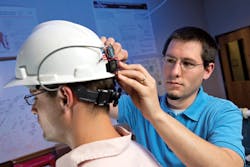PULSE OXIMETRY/HEALTH MONITORING: 'Best paper' describes pulse oximetry-enhanced hard hat to warn workers of CO danger
A pulse oximetry system, integrated into a standard "hard hat," can protect construction workers from carbon monoxide (CO) poisoning: A study evaluating the effectiveness of the innovation showed that the sensor-based helmet would warn its wearer of impending CO poisoning with a probability greater than 99 percent.1
And now, a paper describing the innovation has won its authors an award from the Institute of Electrical and Electronic Engineers (IEEE). The IEEE Transactions on Automation Science and Engineering Best Paper Award was established to recognize one outstanding paper published during the previous calendar year in the publication. In evaluating papers, the judges consider technical merit, originality, potential impact on the field, clarity of presentation, and practical significance for applications. The award comes with a prize of $1,000, and was presented to the Virginia Tech authors at the 2013 IEEE Conference on Automation Science and Engineering (CASE, August 17-21, 2013).
The Virginia Tech team devised the helmet to address the danger of exhaust from gasoline-powered hand tools, which can quickly accumulate in enclosed spaces and easily overcome workers. The paper describes the system as a reflective pulse oximetry device, launching light from at least two light-emitting diodes (LEDs; typically one red and one infrared) and as many as 7 LEDs for more discriminating analysis onto the foreheads of the worker wearing the helmet and processing the reflected signal collected by a photodiode. As the heart beats, hemoglobin concentration values can be calculated by monitoring the blood volume level as a function of wavelength.
The team selected the hard hat as the platform for their system because they needed something that could be worn year-round, and they wanted a socially acceptable design that strikes a balance between comfort, usability, and feasibility. According to the developers, the helmet "is only a first step toward our long-term vision of having a network of wearable and environmental sensors and intelligent personal protective gear on construction sites that will improve safety for workers. While this helmet targets carbon monoxide poisoning, we believe there are compelling opportunities for wearable computing in reducing injuries due to falls, electrocution, and particulate inhalation, as well as workers on foot being struck by vehicles," they explained.
1. J. B. Forsyth, T. L. Martin, D. Young-Corbett, and E. Dorsa, IEEE Trans. Auto. Sci. Eng., 9, 3, 505–515 (2012); doi:10.1109/tase.2012.2197390.

